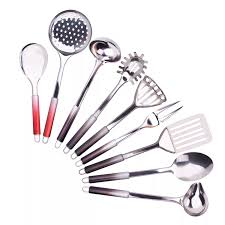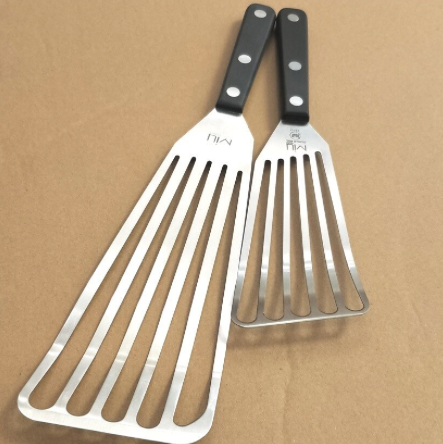Kitchen things with holes
- rosemary
- Feb 8, 2022
- 11 min read
"Dependable and versatile, inexpensive and no-nonsense, it’s possible that a fine mesh strainer is the ideal kitchen tool."
Kendra Vaculin - Epicurious

Not to mention all the other kind of strainers and things with holes that you have in your kitchen.
You might be amazed at how many of your kitchen utensils and equipment have holes, or slots. Think about that for a moment. By hole I don't necessarily mean a round hole, it might be a slot as well. So here are a few random bits of information, musings and so on on holes in the kitchen. I mean just look at this random set of kitchen utensils that I found on the net - at least half of them have holes and/or slots. Not at all sure what you would use the one with the big hole in the bottom for - unless it has a mesh over the hole.
Way back in my rather brief career as an infant school teacher, we did a 'project' on sieves because we had been reading the wonderful Edward Lear bit of nonsense - The Jumblies.
They went to sea in a Sieve, they did, In a Sieve they went to sea: ....
The water it soon came in, it did, The water it soon came in; So to keep them dry, they wrapped their feet In a pinky paper all folded neat, And they fastened it down with a pin. And they passed the night in a crockery-jar, And each of them said, ‘How wise we are! Though the sky be dark, and the voyage be long, Yet we never can think we were rash or wrong, While round in our Sieve we spin!’
I'm not quite sure whether one could theoretically float in a sieve. The original pictures show one of those round wooden sieves, with a wire mesh bottom. I guess the wood would float, although you would indeed get your feet wet, but the jar would have perhaps stayed upright and well above the water. For me the main thing it expresses besides the fun of it all, is an unflappable optimism, Joy.
For my 'project' we mostly did arty things I suppose but we did also talk about all the kinds of sieves that there were. We extended into the garden to those sieves that are the same shape as the Jumblies' good ship. But we also talked about the kitchen.
And before I get back to the kitchen I should just say that the sieve concept is one that is used just about everywhere these days, from medicine, to theoretical and applied physics, medicine and engineering. You name it and sooner or late you will come across a sieve, either real or virtual, fine or coarse.
They also date back millennia. I have seen figures of 10,000 years ago. Below are two very early examples. The one on the left is neolithic and is made of stone in which holes have been punched with a hot iron - they think for making cheese. The other is Egyptian - who amongst other things, used them for winnowing and grading grain - a practice that continues to this day with fundamentally no change other than getting a machine to do it rather than a person.
I also saw talk of a very early version of a plated loop over which was stretched some sheepskin - this was for straining wine and/or beer. Pliny records the Gauls using horsehair, the Spanish used flax and the Egyptians papyrus. The Romans themselves plaited rushed - also for straining wine and oil. So there you go - it all comes down to bread, wine, cheese and oil. Now what does that say? I guess you could say that in just those four ingredients you have eons of social customs and the basic foodstuffs of life. After all behind those four you have the animals that produced some of the material for the sieves, and also the ingredients for the cheese. However, I do think it is so interesting that alcohol is one of the very first things that people made for consumption. And no doubt many learned treatises have been written about this.
But on to the more restricted world of the kitchen - and my particular kitchen at that.
It seems to me that things with holes perform two distinct functions - separating things from each other and making things smoother and finer. Some of the implements only do one thing, some do both. Well I guess if one thinks about it they can probably all do both - up to a point, but nevertheless some are mainly designed for one purpose and the rest for the other. So let's look at all the ones I can think of.
Sieves
I think the picture on the right is actually of various sieves used in engineering - but they represent the kind of sieve that the Jumblies used. All that varies here is the size of the hole, the size of the sieve itself and what the surrounds are made of - everything from wood to plastic.
I actually don't have one of those on the right - although I suspect that professionals use this kind for sifting flour. Sifting flour doesn't just make sure the flour is as fine as possible, but it also aerates it as well because you are supposed to hold it up high and tap it on the side. I confess I often don't sift flour and I have actually seen some cooks say that these days with modern milling methods it isn't necessary, but then there's also a lot of faff about what kind of flour you use as well. Anyway when I do sift flour - or other things - I just use my largest sieve of the left hand kind.

You can use that kind of sieve to strain things as well, as long as you don't have vast quantities, because it has a handle that will balance on a bowl or a sink. In fact I also have this Aldi strainer which fits in the sink and is perfect for leaving fruit to drain when you have washed it.
I also have a very small sieve which is used for straining tea leaves - or coffee grounds if you have no other way of making coffee. It's sometimes happened to us in rented holiday homes. When we have had to resort to pouring boiling water over ground coffee and then straining it through one of these small sieves. I think we may even have had to buy one once.
What else can you do with a common or garden sieve? Well that final decorative dusting of icing sugar or cocoa over your undecorated cake. You can separate an egg yolk from the white by breaking it into a sieve over a bowl - brilliant. I think there's a way of poaching an egg with it as well. You can use it as a steamer. I was also told long ago by a friend that if you had made a sauce which was lumpy just pour it through a sieve and push the last bits through - eh voilà - smooth sauce. Yes it works.

And now that I think about this, sieves are also used for making things finer by pushing them through the holes, leaving the unwanted stuff behind - you can make your ricotta smoother this way for example. Also fish soup - which I do not recommend because that is very, very tedious. Just order fish soup every time you see it on a menu because it's divine and a real pain to make.

I also have a much larger conical sieve which was given to me by my pasta loving son for straining pasta. And that's all I use it for although it seems that chefs use it for straining things to make them very smooth because of the very fine holes. Well mine doesn't have very fine holes. I would use my sieves for fine. It's also a bit awkward because of its shape if you want to keep the water or stock that you are straining off. You would need a very tall bowl to take the run off. So yes, for me, it's just for pasta. It's proper name by the way is a chinois - which means Chinese.

Last sieve - is a tea infuser. Since infusing tea is very fashionable these days they come in much fancier materials and shapes than these - but these are what my one looks like. I think it was a gift with a tiny teapot from one of my staff - a Sri Lankan lady. I was touched.
Defining feature of a sieve? Small holes I think.

Colanders I'm not such a fan of colanders. They never seem to strain properly to me. Some of the liquid is always left behind. Certainly if they are made of metal. I suspect a plastic one might work better. But maybe that's just the colanders that I have. Colanders are also very old although I saw one article that said they predated sieves - which I can sort of understand. It is surely easier to punch some holes in a clay pot than weave a sieve? But then another article implied that sieves predated colanders so who knows.
Some of them are mini works of art these days, but looking at the pictures above reminds me that I have a metal thing on my sink that has holes in it, in which I keep the metal scrubbing things and a brush. And I just thought of another one - the plughole in your kitchen sink which will probably have some kind of strainer in it. Plug holes these days tend to have a stopper with holes that either can be open or closed, and you can also get a sort of tea strainer thing to put in the hole to strain off finer stuff.
So mostly used for straining things. I use mine for straining stock mostly. David tends to put the washed fruit in them, but as I said, this doesn't work - the water collects in the bottom. Not enough holes. They do perch over a bowl in which to catch the strainings - in my case the stock - in a rather better way than the conical ones.

And let's not forget that ancient use of the sieve or colander - more properly the colander as the holes were relatively large - straining cheese. As shown here in the Parmiggiano factory we visited way back in 2014 - where the leftover whey was boiled up, until it separated into curds and more whey and poured into little perforated baskets - colanders really. And of course we bought one.
Finally - a somewhat specialised kind of colander/straining device are those little ceramic dishes with holes in the bottom that are used for making fromage frais coeur à la crème. I have always wanted to make this, but have never found the dishes. As I shall never be going to France again I guess I could look online.
So yes - colanders are best used for straining I think.

Salad baskets and spinners - All those years ago in the village of Meung-sur-Loire, Madame Coutant would wash her salad leaves, and place them in a salad basket like this one. She would then go out onto the balcony and vigorously swing it from side to side over the balcony railing. Result - dry salad greens. I had to have one, so I bought one, and have it still. Some of the bits that enclose the salad at the top have come unhinged over time, but David has recently done one of his miracle repair jobs and it is now as good as new. I did have a salad spinner as well - one of those plastic things into which you put your salad and then spin using some kind of handle. It is very effective too, but it takes up so much space in your cupboards so I threw it out some time ago.

Again, if you are stuck in an ill equipped holiday house there is another way - wrap your salad in a tea towel, make sure that it is secured tightly, go outside and swing that around your head. Also effective. You will end up with dry salad and a wet tea towel. This technique was demonstrated to us by a good friend with whom we were holidaying. He was an engineer.

Wire baskets are also a kind of strainer in that they are good for storing things like eggs, and onions. I guess it allows them to breathe the air - so in this case the air is not being strained out but being allowed to get in. More useful in the time before fridges I think, but decorative none the less. If you have the room.

Muslin, tea towels, chux
Going back to the tea towel trick if you want really fine straining, then you will need, ideally, some muslin, although a tea towel or a Chux would probably do the trick. Used for jelly, labne and really, really fine sauces. And in a commercial sense, for making sure your wine and olive oil are clear as glass. You need to live near a Spotlight though to get muslin.
And I suppose if we are talking fine straining then we should not forget coffee filters.
You might think I've finished. But no.
Slotted spoons - almost endless variations here, although some perhaps slide into other categories. Below is a range of such items.
Some have round holes of various sizes, ranging from tiny ones for skimming - these tend to be flatter as well - to large ones for taking out big things like vegetables from a sauté. Some have slots. I guess they serve the same purpose, although the larger ones are more for removing fish or large pieces of meat from a frying pan. Woks have their own variations of slotted spoons like the last picture above. These come in varying shapes as well. I saw one recently in Aldi that was more like the chip basket shown above, but narrower. And I guess those pronged pasta server/strainers count too. As I said, call of these things are mostly used for straining hot things.
Graters and slicers
Ok - these days we have food processors that do a lot of this stuff, or at the other end of the spectrum - knives. But I have to say I use my grater a lot - mostly the old-fashioned box grater, but sometimes the flashy Parmesan graters and occasionally a mandoline. But I'm a bit wary of that one, although I think I have actually done more damage to myself on a box grater than the mandoline. I used to have one of those drum graters for cheese, but I don't know why really. I also used to have a similar one which shredded herbs. Souvenirs of France perhaps. Also long gone. I use a knife for that. Different sized holes for different purposes, and I think I dedicated a whole blog to graters once, so I shall stop there.

As to slicing - does this egg slicer count do you think? I also have a tomato slicer which is just a hand-held thing rather like the wires on the egg slicing machine. You sort of rub your tomato through it and get even sized slices. Mostly I just use a knife though I have to confess.
You can slice on a box grater, or in a food processor, but it's not really worth the bother of the food processor, so I tend to just laboriously slice things by hand. Silly me.
Mashers and mincers
If you want to just mash your potatoes, sweet potatoes, pumpkin, whatever, roughly, so that you end up with a few lumps then use a masher. I do when I'm in a hurry. The vintage mouli légumes in the middle though - the exact same model I used to own - is another thing that I brought back from that first holiday in a French home. Madame used it every night to make soup, and I used it for soup, purée de pommes de terre, and other purées - particularly baby food in later years. It died of rust, but it was replaced because I simply can't do without it when it comes to those real puréed potatoes or when I am making marmalade. Otherwise, like everybody else, these days I mostly use a food processor, or a stick blender for the soup. And I used to have a mincer as in the picture which I used to mince the leftover roast for shepherd's pie, but that is long gone. Then I had an attachment to my electric mixer - well I still have, but I never use it. No - the food processor has taken over there. So perhaps this little group is on the way out.
Racks - last category I promise.
Grill racks - the picture shows one on a barbecue, but you've doubtless got one for your oven too - ditto for the various racks you have for cooling cakes and cookies, and roasting meat and steaming fish - which leads naturally to steamers of various kinds - from one that looks a bit like a colander, through those half circle ones for your wok, the plastic tray in your rice cooker and the bamboo steamers that the Chinese use.
So have I left anything out? Let me know if I have. It's a pretty long list though. Of mostly very simple things which have been around for eons in one form or another. But outside of the kitchen they are very, very sophisticated engineering, and scientific devices.
Can't do without them though.

















































Comments